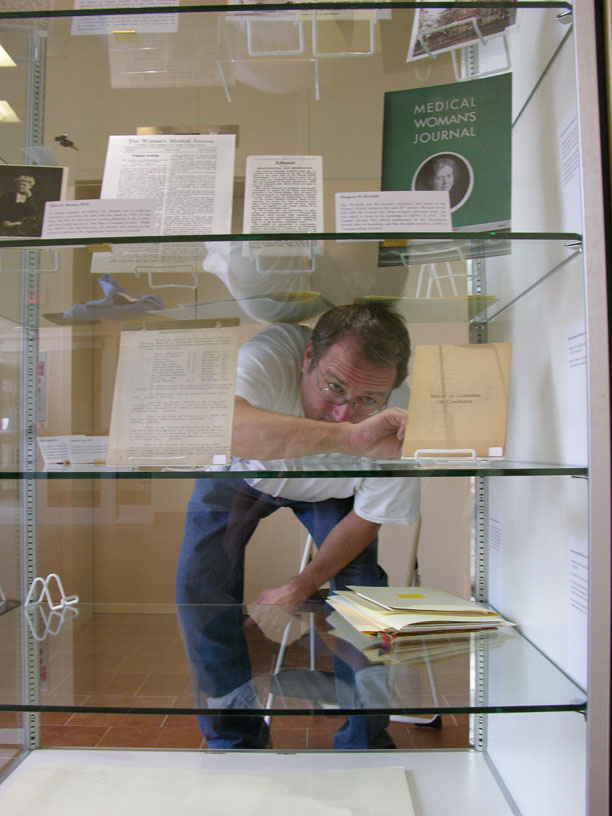Open for Interpretation: Squeezing more use out of our collections
by Matt Herbison

We've been preparing for three exhibits, one opened last week and two others are fast approaching:
September 24: Parallel exhibits on the early history of American Medical Women’s Association and American Women’s Hospital Service, developed through the hard work of excellent intern Alex Miller -- that's Alex setting up the case in the photo. Exhibit in our lobby.
October 6: Changing the Face of Medicine, a traveling exhibit put together several years ago by the National Library of Medicine (online exhibition at NLM) that uses a lot of our collection material. We'll be supplementing the traveling component with a couple exhibit cases of original items.
October 21: Kickoff event and exhibit associated with the conference for the far-reaching Vision 2020 gender equality initiative. At the National Constitution Center in Philly.
"Interpretation," if you aren't familiar with it, is a term most often used by museum folks. That's an understatement: Interpretation is the word that drives museum folks. It refers to selection of artifacts and archives to illustrate a certain theme or story.
Interpretation is the process that uses a story to connect the stuff to the audience.
Two different groups of archival materials could be used to illustrate the same story. Or one group of materials could illustrate multiple stories.
As an archivist, I love interpretation:
- Interpretation creates use: We're not waiting for the researchers to come to us, we're getting out into the physical and online communities to bring the stories to them. The wonderful thing is that interpretative cycles back onto itself -- the increased awareness leads to more researchers becoming interested and can even result in new donations of archival materials.
- Interpretation creates a story: People love stories about people and events. And our collections are full of stories of people who have the grit and gumption (dagnabbit) to actually inspire people. Exhibits and other outreach efforts make these stories relevant to people's lives.
- Interpretation is creative: It is challenging and fun to create something that tells a story, uses historical documents and artifacts, and appeals to a wide audience. Interpretation allows us to be partial and to tell a story from a certain point of view. Haha! Take that, objectivity!
As I understand it -- I'm new here by the way -- this sort of exhibit development is not something we've been intensively involved in until recently. But as of late, we're all about interpretation. In addition to these three exhibits, we have our upcoming planning grant to use online archives in Grades 6-12 (more about this is a previous post).
I love researchers, they're probably my favorite part of the job, but I think interpretation, outreach and education are the direction archival repositories need to go to really be valuable to society. For every 10 researchers who use our collections in-depth, we might have hundreds or thousands of users of our exhibits or teacher materials. The wonderful thing is that this isn't an either-this-or-that calculation, we can do both. We should do both. And both feed into each other: Use begets use.
Want to see these exhibits? Well you've got me there...you'll have to visit the places they're installed. Or you can wait until we get our online exhibit space up and running.